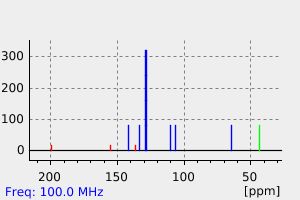3-(呋喃-2-基)-3-羟基-1-苯基丙烷-1-酮 | 87831-11-6
中文名称
3-(呋喃-2-基)-3-羟基-1-苯基丙烷-1-酮
中文别名
——
英文名称
3-(2-furyl)-3-hydroxy-1-phenylpropan-1-one
英文别名
3-(Furan-2-yl)-3-hydroxy-1-phenylpropan-1-one
CAS
87831-11-6
化学式
C13H12O3
mdl
——
分子量
216.236
InChiKey
MJCYHEPHYJROIU-UHFFFAOYSA-N
BEILSTEIN
——
EINECS
——
-
物化性质
-
计算性质
-
ADMET
-
安全信息
-
SDS
-
制备方法与用途
-
上下游信息
-
文献信息
-
表征谱图
-
同类化合物
-
相关功能分类
-
相关结构分类
计算性质
-
辛醇/水分配系数(LogP):1.5
-
重原子数:16
-
可旋转键数:4
-
环数:2.0
-
sp3杂化的碳原子比例:0.15
-
拓扑面积:50.4
-
氢给体数:1
-
氢受体数:3
上下游信息
-
下游产品
中文名称 英文名称 CAS号 化学式 分子量 —— (R)-3-(2-furyl)-3-hydroxy-1-phenylpropan-1-one 145624-52-8 C13H12O3 216.236
反应信息
-
作为反应物:描述:3-(呋喃-2-基)-3-羟基-1-苯基丙烷-1-酮 在 potassium fluoride 、 C50H34F12O6 作用下, 以 甲苯 为溶剂, 反应 10.0h, 以50%的产率得到(R)-3-(2-furyl)-3-hydroxy-1-phenylpropan-1-one参考文献:名称:通过使用阳离子结合催化剂的对映选择性脱水进行β-羟基羰基化合物的动力学拆分:轻松获得对映纯手性醇醛摘要:通过使用阳离子结合的宋氏低聚乙二醇(oligoEG)催化剂,以氟化钾(KF)为基础,开发了通过对映选择性脱水过程开发的外消旋β-羟基羰基(aldol)化合物的实用且高度对映选择性的非酶动力学拆分方法。在温和的反应条件下,极高的选择性因子(s =高达2393)可分离出多种外消旋醇醛。该协议易于扩展。它为合成对映体纯形式的多种生物学和药学上相关的手性醇醛提供了另一种方法。例如,外消旋姜醇可以以极高的效率(s> 240),在一个步骤中同时提供对映体纯的姜黄醇和相应的Shogaols。这种动力学拆分过程的显着效果可归因于在由手性催化剂,底物和KF产生的密闭超分子手性笼中的系统协同氢键催化。DOI:10.1021/acs.orglett.8b00547
-
作为产物:描述:2-(2-phenyl-cyclopropyl)-furan 在 氧气 、 dioxide titanium 作用下, 以 乙腈 为溶剂, 反应 10.0h, 以52%的产率得到3-(呋喃-2-基)-3-羟基-1-苯基丙烷-1-酮参考文献:名称:将双氧的两个氧原子一次全部排列成脂族C(sp 3)-C(sp 3)键以进行羟基酮双官能化摘要:β-和γ-羟基酮结构都是生物活性分子,合成药物和精细化学品中的重要单元。尽管有一些方法可以从一个或两个基质分子上的预官能团制造它们,但是将双氧中的两个氧原子简单并同时沉积到纯饱和烃的两个特定C(sp 3)位置的方法有很少成功,因为它们一次都参与了三个惰性CHσ键的靶向活化。在这里,我们表明TiO 2 -CH 3 CN光催化悬浮体系能够将双氧插入一个C(sp 3)-C(sp 3)应变环烷烃衍生物的键,通过一锅反应获得双官能化的羟基酮产物。通过裂解事件以释放应变作为方向驱动力,按设计的光催化反应系统显示,三元环衍生物的21个实例的β-羟基酮产物的分离产率为31%-76%,而5个实例的γ-羟基酮产物的分离产率为31%-76%。四元环底物的孤立产率为30%–63%。使用18 O 2,Ti 18 O 2和有意添加的H 2 18进行18 O同位素标记实验O,分别表示的羟基酮产品两个氧原子都完全由双氧,表明先前未知的ħDOI:10.1007/s11426-020-9949-7
文献信息
-
Pyridinium salts structurally related to NAD(P)+ as enolate transferring agents作者:Sabir H. Mashraqui、Richard M. KelloggDOI:10.1021/ja00364a079日期:1983.12La reaction du bromure de propyl-1 phenylcarbamoyl-3 pridinium avec l'acetophenone conduit au benzoylmethyl-4 propyl-1 dihydro-1,4 N-phenylnicotinamide qui, en solutions Mg(ClO 4 ) 2 •2H 2 O subit une condensation aldolique avec des aldehydesLa 反应 du bromure de 丙基-1 phenylcarbamoyl-3 pridinium avec l'acetophenone 管道 au benzoylmethyl-4 propyl-1 dihydro-1,4 N-phenylnicotinamide qui, en 溶液 Mg(ClO 4 ) 2 •2H 2 O subit une 缩合醛乙醛
-
Carbon–carbon bond formation between α-halogenoketones and aldehydes promoted by cerium(<scp>III</scp>) iodide or cerium(<scp>III</scp>) chloride–sodium iodide作者:Shin-Ichi Fukuzawa、Tatsuo Fujinami、Shizuyoshi SakaiDOI:10.1039/c39850000777日期:——α-Halogenoketones react with aldehydes to form α,β-unsaturated ketones accompanied by dehalogenation in the presence of cerium(III) iodide, but use of cerium(III) chloride–sodium iodide results in the formation of β-keto alcohols.
-
The Aldol Reaction under High-Intensity Ultrasound: A Novel Approach to an Old Reaction作者:Giancarlo Cravotto、Alberto Demetri、Gian Mario Nano、Giovanni Palmisano、Andrea Penoni、Silvia TagliapietraDOI:10.1002/ejoc.200300369日期:2003.11We have employed high-intensity ultrasound (HIU) to reinvestigate the aldol reaction (AR) in water. A number of aldols that under usual conditions would undergo elimination were isolated in acceptable to good yields. Within 15−30 min, acetophenone reacted with non-enolizable aldehydes to afford the aldol exclusively, while under conventional conditions (stirring or heating under reflux) the same compounds
-
Roux, C. Le; Gaspard-Iloughmane, H.; Dubac, J., Bulletin de la Societe Chimique de France, 1993, vol. 130, p. 832 - 842作者:Roux, C. Le、Gaspard-Iloughmane, H.、Dubac, J.DOI:——日期:——
-
Fukuzawa, Shin-ichi; Tsuruta, Takuya; Fujinami, Tatsuo, Journal of the Chemical Society. Perkin transactions I, 1987, p. 1473 - 1478作者:Fukuzawa, Shin-ichi、Tsuruta, Takuya、Fujinami, Tatsuo、Sakai, ShizuyoshiDOI:——日期:——
表征谱图
-
氢谱1HNMR
-
质谱MS
-
碳谱13CNMR
-
红外IR
-
拉曼Raman
-
峰位数据
-
峰位匹配
-
表征信息
同类化合物
(反式)-4-壬烯醛
(s)-2,3-二羟基丙酸甲酯
([1-(甲氧基甲基)-1H-1,2,4-三唑-5-基](苯基)甲酮)
(Z)-4-辛烯醛
(S)-氨基甲酸酯β-D-O-葡糖醛酸
(S)-3-(((2,2-二氟-1-羟基-7-(甲基磺酰基)-2,3-二氢-1H-茚满-4-基)氧基)-5-氟苄腈
(R)-氨基甲酸酯β-D-O-葡糖醛酸
(5,5-二甲基-2-(哌啶-2-基)环己烷-1,3-二酮)
(2,5-二氟苯基)-4-哌啶基-甲酮
龙胆苦苷
龙胆二糖甲乙酮氰醇(P)
龙胆二糖丙酮氰醇(P)
龙胆三糖
龙涎酮
齐罗硅酮
齐留通beta-D-葡糖苷酸
鼠李糖
黑芥子苷单钾盐
黑海棉酸钠盐
黑木金合欢素
黑曲霉三糖
黑介子苷
黄尿酸8-O-葡糖苷
麻西那霉素II
麦迪霉素
麦芽糖脎
麦芽糖基海藻糖
麦芽糖1-磷酸酯
麦芽糖
麦芽四糖醇
麦芽四糖
麦芽十糖
麦芽六糖
麦芽五糖水合物
麦芽五糖
麦芽五糖
麦芽五糖
麦芽三糖醇
麦芽三糖
麦芽三糖
麦芽三塘水合
麦芽七糖水合物
麦芽七糖
麦法朵
麦可酚酸-酰基-Β-D-葡糖苷酸
麦利查咪
麝香酮
鹤草酚
鸢尾酚酮 3-C-beta-D-吡喃葡萄糖苷
鸡矢藤苷







